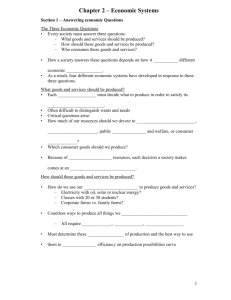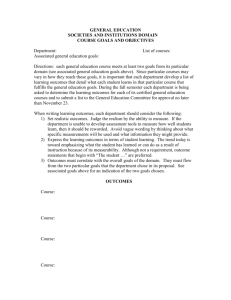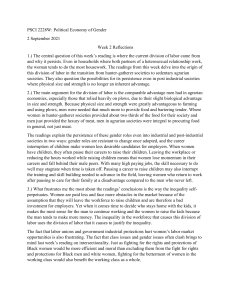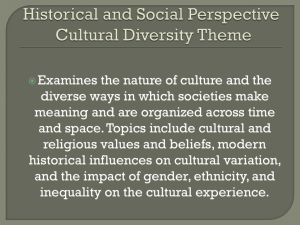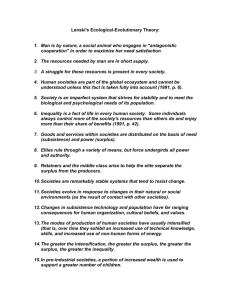Sociology Theorists & Perspectives Matching Worksheet
advertisement
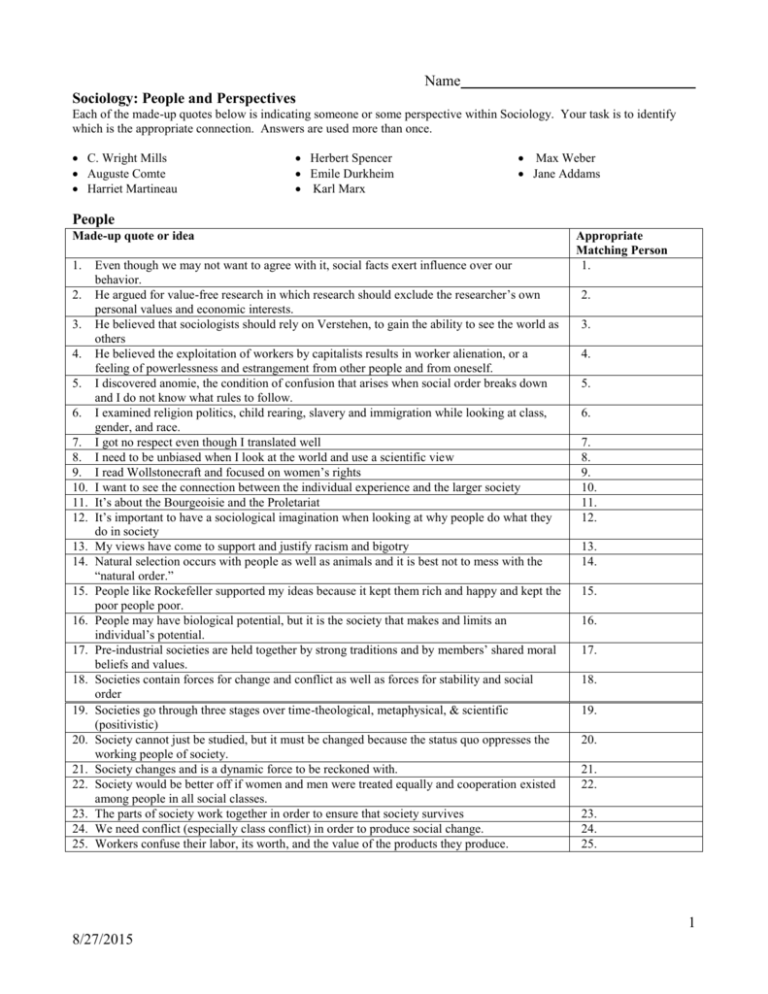
Name Sociology: People and Perspectives Each of the made-up quotes below is indicating someone or some perspective within Sociology. Your task is to identify which is the appropriate connection. Answers are used more than once. C. Wright Mills Auguste Comte Harriet Martineau Herbert Spencer Emile Durkheim Karl Marx Max Weber Jane Addams People Made-up quote or idea 1. 2. 3. 4. 5. 6. 7. 8. 9. 10. 11. 12. 13. 14. 15. 16. 17. 18. 19. 20. 21. 22. 23. 24. 25. Even though we may not want to agree with it, social facts exert influence over our behavior. He argued for value-free research in which research should exclude the researcher’s own personal values and economic interests. He believed that sociologists should rely on Verstehen, to gain the ability to see the world as others He believed the exploitation of workers by capitalists results in worker alienation, or a feeling of powerlessness and estrangement from other people and from oneself. I discovered anomie, the condition of confusion that arises when social order breaks down and I do not know what rules to follow. I examined religion politics, child rearing, slavery and immigration while looking at class, gender, and race. I got no respect even though I translated well I need to be unbiased when I look at the world and use a scientific view I read Wollstonecraft and focused on women’s rights I want to see the connection between the individual experience and the larger society It’s about the Bourgeoisie and the Proletariat It’s important to have a sociological imagination when looking at why people do what they do in society My views have come to support and justify racism and bigotry Natural selection occurs with people as well as animals and it is best not to mess with the “natural order.” People like Rockefeller supported my ideas because it kept them rich and happy and kept the poor people poor. People may have biological potential, but it is the society that makes and limits an individual’s potential. Pre-industrial societies are held together by strong traditions and by members’ shared moral beliefs and values. Societies contain forces for change and conflict as well as forces for stability and social order Societies go through three stages over time-theological, metaphysical, & scientific (positivistic) Society cannot just be studied, but it must be changed because the status quo oppresses the working people of society. Society changes and is a dynamic force to be reckoned with. Society would be better off if women and men were treated equally and cooperation existed among people in all social classes. The parts of society work together in order to ensure that society survives We need conflict (especially class conflict) in order to produce social change. Workers confuse their labor, its worth, and the value of the products they produce. Appropriate Matching Person 1. 2. 3. 4. 5. 6. 7. 8. 9. 10. 11. 12. 13. 14. 15. 16. 17. 18. 19. 20. 21. 22. 23. 24. 25. 1 8/27/2015 Perspectives Conflict Symbolic Interactionist Functionalist Made-up quote or idea 26. A division of labor (distinct, specialized functions) between husband and wife is essential for family stability and social order. 27. A key feature distinguishing humans from other animals is the ability to communicate in symbols. 28. Adverse consequences that affect one institution affect all others as well. 29. All societies must make provisions for meeting social needs in order to survive. Appropriate Matching Perspective 26. 27. 28. 29. 30. Contains the idea of dramaturgical analysis, which makes an analogy between social life and 30. that of the stage. 31. Groups with divergent interests engage in ongoing power struggles for control of scarce 31. resources in society. 32. Latent functions are unintended functions that are hidden and remain unacknowledged. 32. 33. Manifest functions are intended and overtly recognized by the participants in an institution. 33. 34. Recognized the importance of economic conditions in producing inequality, but also thought 34. that power and prestige were other sources of inequality. 35. Societies develop social structures, or institutions that persist because they play a part in 35. helping society survive. These institutions include: the family, education, government, religion, and economy. 36. Society consists of interrelated parts that serve functions needed by the system. 36. 37. Symbols are anything that meaningfully represents something else. 37. 38. Symbols must be interpreted in the same way to produce a shared reality. 38. 39. The power elite—a small clique composed of the top corporate, political, and military officials—makes the most important decisions in the United States, largely behind the scenes. 40. Their most basic assumption of this perspective is that society is a stable, orderly system characterized by societal consensus. 41. These theorists focus on how inequalities based on race, sex, and income affect people’s ability to acquire things they want and need. 39. 40. 41. 2 8/27/2015





